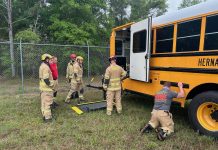In a joint letter to the National Transportation Safety Board (NTSB) released today, NAPT and NSTA stated they will support the board’s recommendation regarding biannual training on proper seat-belt usage where applicable — but will not support a recommendation to advise their members to consider three-point belts when purchasing new school buses.
The two associations emphasized they won’t follow this specific guidance “until the significant and conflicting policy differences between the two federal safety agencies (NHTSA and NTSB) are resolved, hopefully with the added science of dynamic crash testing that is customary and routine for all other motor vehicle recommendations and requirements.”
NAPT and NSTA added that NTSB’s conclusions and recommendations regarding three-point seat belts on school buses added to their “conundrum” as trade associations that must understand and represent differing state and local views on this controversial topic.
“Many NAPT and NSTA members remain very concerned about the ‘unintended consequences’ of belt use that NHTSA articulated in its 2011, 2010 and 2002 rulemakings and do not understand why the NTSB is not making a strong recommendation that NHTSA conduct the ‘sufficient research’ the agency said it would undertake nearly a decade ago or at least show the results of the work it said nearly 4 years ago would be completed ‘soon,’” they said.
NAPT and NSTA wrote that they feel so strongly about the lack of “necessary science” that the former may again petition NHTSA to conduct dynamic crash tests of school buses and evaluate kinematics in all of the various crash modes — especially side, oblique and rollover crashes.
Their stance represents a departure from NASDPTS, which previously expressed support for both recommendations made by the NTSB following its investigations of two fatal school bus crashes in Chesterfield, N.J., and Port St. Lucie, Fla.
In July, NTSB requested that NAPT, NSTA, NASDPTS, the School Bus Manufacturers Technical Council and the National Safety Council’s School Transportation Section provide their members with educational materials on lap-shoulder belts and to advise all members to consider this type of belt, rather than two-point lap belts, when purchasing school buses with occupant restraint systems.
NSTA and NAPT said they intend to work collaboratively on this matter, according to the recent NSTA newsletter. They also said they will seek input from their members to identify best practices for the proper use of safety belts in buses and then develop recommended policies and procedures “well before” the 2015 National Congress of School Transportation.
“NSTA and NAPT believe research and its results, rather than emotion, should guide decisions about the use of safety belts on buses,” read the newsletter item.
Despite their refusal to follow NTSB’s direction on the seat belt issue, their Dec. 9 letter noted they continue to have tremendous respect for the NTSB and consider its recent recommendations the starting point for future collaboration on this “important” topic. NAPT and NSTA also agreed to work with NASDPTS to review the next update of the National School Transportation Specifications and Procedures so that states with belt-use requirements have the latest information on their proper installation and usage.
The associations’ letter also addressed the recent NHTSA decision that mandates three-point, lap-shoulder belts for passenger and driver seats on all new motorcoaches beginning in 2016. With the general public and news media asking, “Why motorcoaches but not school buses?” NAPT and NSTA said they are prepared to explain to them that school buses, motorcoaches and the family car are very different vehicles from a crashworthiness perspective and thus do not necessarily utilize the same safety strategies.
“We continue to believe that our safety record demonstrates that the ‘automatic’ approach to protecting children in school buses, that was mandated for school buses by federal safety officials before seat-belt use became popular, remains extremely effective,” they concluded.















